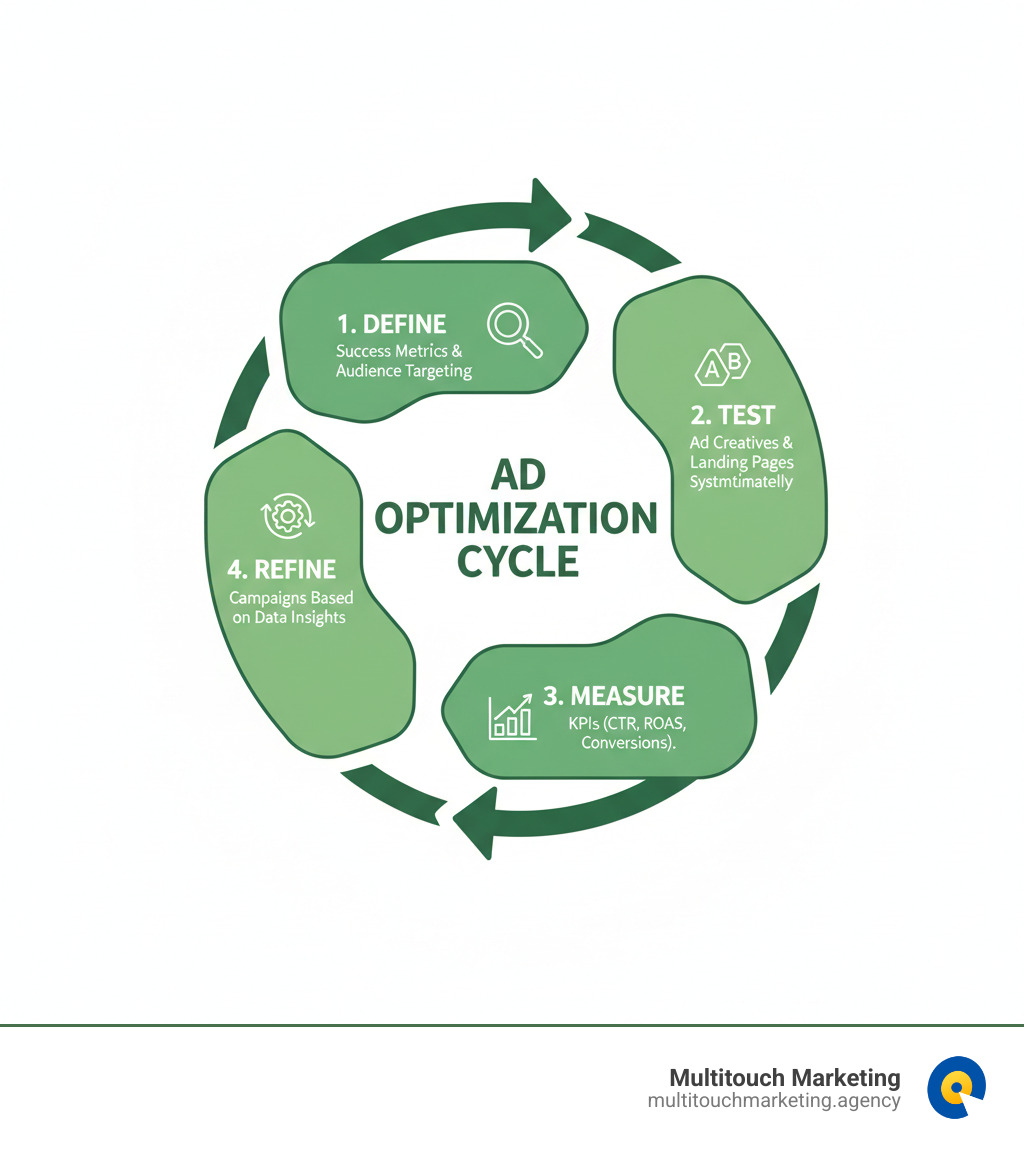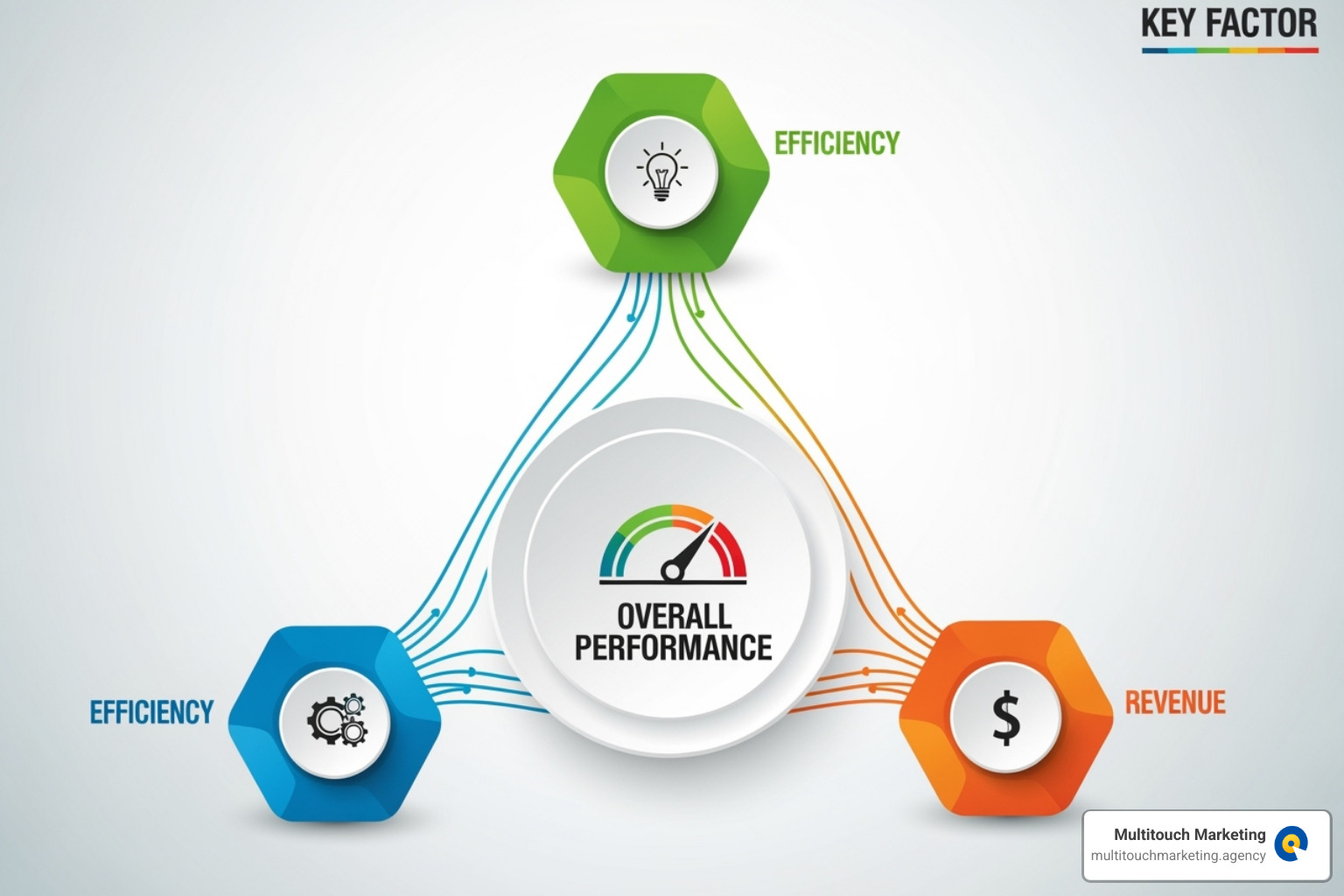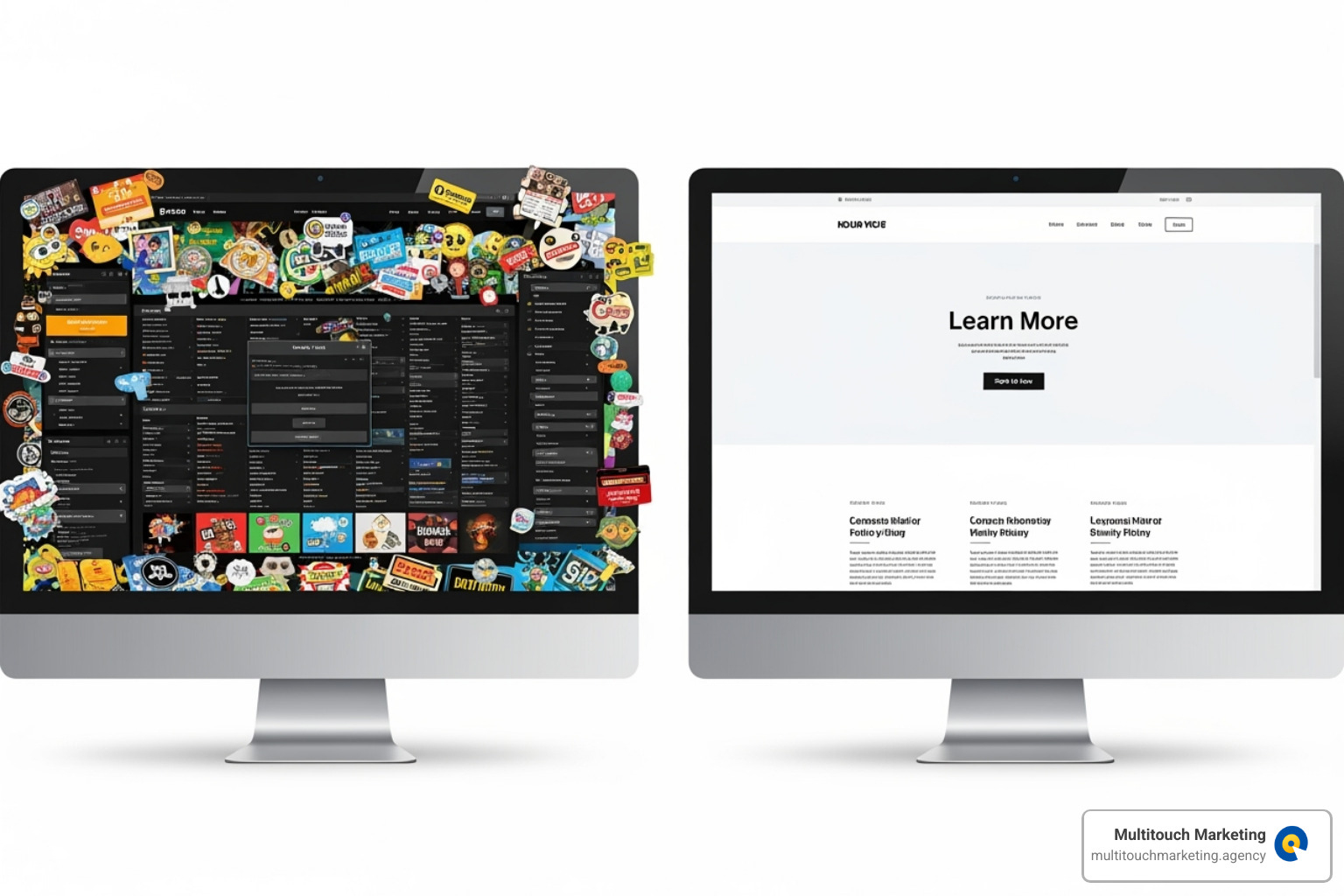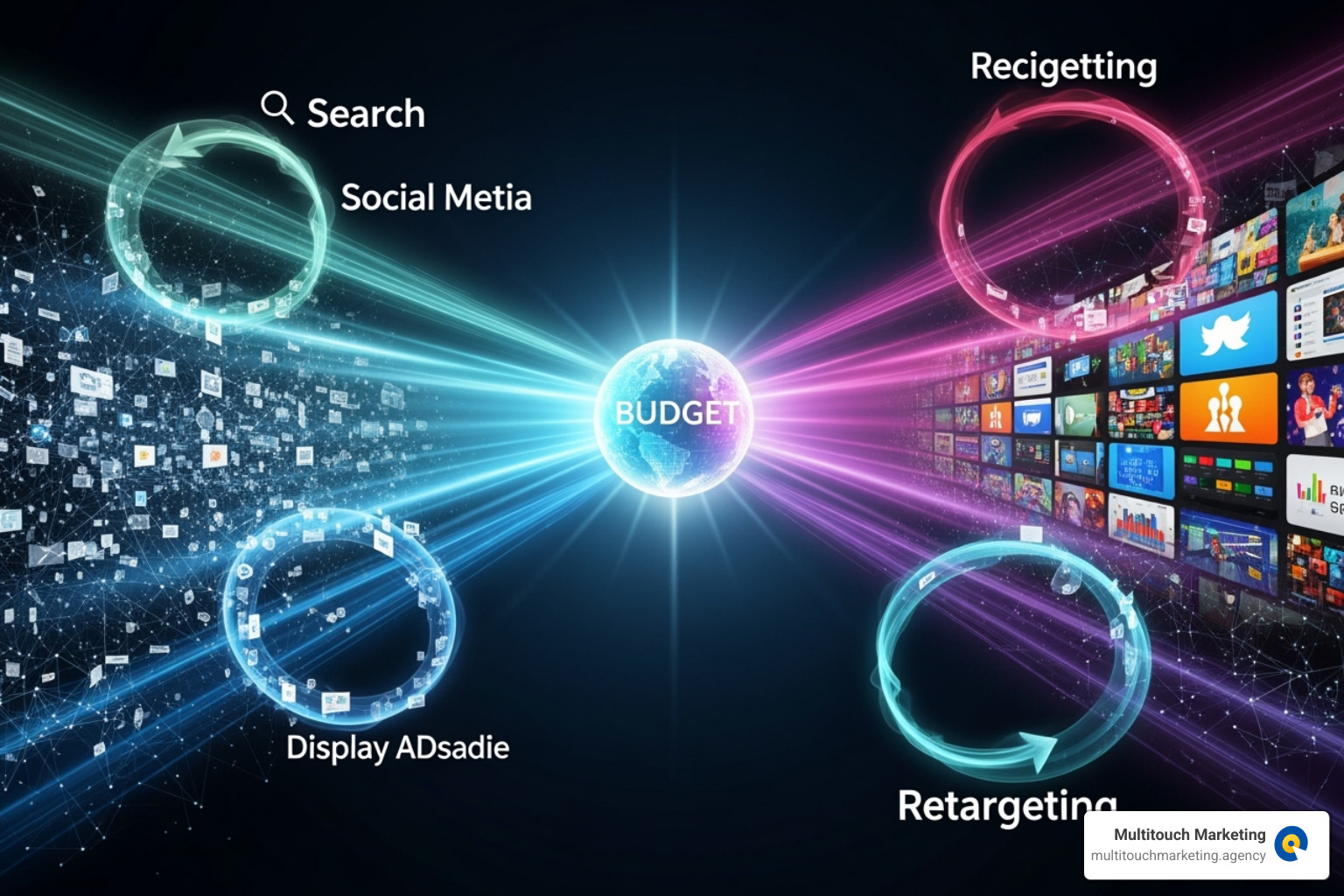Why Ad Performance Matters More Than Ad Spend
Improve ad performance is the difference between throwing money at platforms and building a profitable marketing engine. With 70-80% of users completely ignoring paid ads and digital advertising costs rising yearly, smart advertisers focus on optimization over spending.
Quick Ways to Improve Ad Performance:
- Define clear success metrics – Set specific KPIs beyond just clicks
- Understand your audience – Research pain points and search intent
- Optimize Quality Score – Focus on ad relevance, expected CTR, and landing page experience
- Test everything – A/B test ad copy, visuals, and landing pages systematically
- Choose the right channels – Align platforms with your audience and goals
- Track what matters – Monitor conversion rate, CPA, and ROAS, not just vanity metrics
The reality is harsh: 74% of consumers prefer ads that match the content they’re viewing, yet most campaigns fail due to poor targeting, unclear messaging, or irrelevant landing pages. Companies that restrict themselves to ‘performance’ advertising alone incur an ROI penalty, according to new research from WARC.
But there’s good news. Businesses earn an average of $2 for every $1 spent on Google Ads when campaigns are properly optimized. The key isn’t spending more – it’s spending smarter through systematic testing, audience understanding, and continuous refinement.
I’m Milton Brown, and I’ve managed paid media campaigns ranging from $20,000 to $5 million across higher education, e-commerce, and healthcare organizations since 2008. Throughout my career, I’ve learned that the most effective way to improve ad performance is through data-driven optimization rather than increased budget allocation. This guide will show you exactly how to transform your ad spend into measurable results.

Laying the Groundwork: Defining Success and Understanding Your Audience
Think of launching ad campaigns without clear goals like trying to hit a dartboard in the dark. You might get lucky, but you’ll probably waste a lot of arrows. Before we dive into the exciting world of ad creation and budget allocation, we need to establish two fundamental pillars: knowing exactly what success looks like and understanding who we’re talking to.
Define and Measure Your Campaign Performance
Here’s the truth: “getting more sales” isn’t a goal – it’s a wish. Real success starts with specific, measurable objectives that connect directly to your bottom line. Do you want to reduce customer acquisition costs by 15% over the next quarter? Increase holiday revenue by $50,000? These concrete targets become your North Star Metric – the one number that matters most to your business growth.
Once you’ve defined success, you need the right Key Performance Indicators (KPIs) to track your progress. But here’s where many businesses stumble: they get seduced by vanity metrics that look impressive but don’t move the needle.
Click-Through Rate (CTR) tells you if people find your ads compelling enough to click. While a healthy CTR is important, it’s just the first step. A brilliant CTR means nothing if those clicks don’t convert into customers.
Conversion Rate (CVR) reveals the real story – what percentage of your visitors actually take the action you want. This metric shows whether your ads are attracting the right people and whether your landing pages seal the deal.
Cost Per Acquisition (CPA) keeps you honest about efficiency. It’s the true cost of gaining each new customer through your ads. Lower CPA means you’re spending smarter, not necessarily harder.
Return on Ad Spend (ROAS) is where the rubber meets the road. This metric shows exactly how much revenue each advertising dollar generates. A ROAS of 4:1 means every dollar spent brings back four dollars in revenue.
Customer Lifetime Value (LTV) takes the long view. While it might cost $100 to acquire a customer today, if they’re worth $500 over their lifetime, that’s a fantastic investment. Smart advertisers always consider the LTV-to-CPA ratio when evaluating campaign success.
Setting up accurate tracking isn’t glamorous, but it’s absolutely critical. Without proper conversion tracking, you’re flying blind. This means implementing comprehensive tracking across your website and advertising platforms, then testing everything to ensure the data flows correctly.
First-party data – information you collect directly from your customers – becomes more valuable every day. As tracking restrictions tighten and cookies disappear, businesses that invest in their own data collection will have a massive advantage. For deeper insights on leveraging your data effectively, explore our Data-Driven Marketing Strategies.
The Critical Role of Audience Understanding
Demographics tell you who your customers are. Psychographics tell you why they buy. The magic happens when you understand both.
Real people have complex motivations that go far beyond age and income brackets. They have pain points that keep them up at night, search intent that drives their online behavior, and emotional triggers that influence their decisions. Your job is to understand these human elements and speak directly to them.
When we say 74% of consumers prefer ads that match the content they’re viewing, we’re talking about relevance at a deeper level. It’s not enough to show cooking ads to people reading recipe blogs. You need to understand whether they’re stressed weeknight dinner planners or adventurous weekend chefs – because these audiences need completely different messages.
This is where buyer personas become invaluable. But don’t create fictional characters – build profiles based on real customer data, sales team insights, and conversations with actual buyers. Understanding the customer journey helps you deliver the right message at exactly the right moment.
Audience targeting works best when you’re specific rather than broad. Instead of targeting “everyone interested in fitness,” target “busy parents looking for 20-minute home workouts.” This specificity might reduce your audience size, but it dramatically improves relevance and conversion rates.
Smart advertisers also use audience exclusions to avoid wasting budget on people who’ll never convert. Why show ads to your current customers when you could be reaching new prospects?
Regular audience research isn’t a one-time task – it’s an ongoing conversation with your market. Customer needs evolve, new competitors emerge, and market conditions shift. The businesses that stay connected to their audience insights consistently outperform those that set-and-forget their targeting.
Our guide on Social Media Audience Insights dives deeper into practical techniques for understanding and reaching your ideal customers across different platforms.
When you combine crystal-clear success metrics with deep audience understanding, you’re not just improving ad performance – you’re building a foundation for sustainable, profitable growth.
Mastering the Auction: How to Improve Ad Performance with Quality Score and Targeting
Now that we understand our goals and our audience, it’s time to dive into the mechanics of how ad platforms actually work. Think of it like learning the rules of a game before you start playing. At the heart of many paid search campaigns, especially on Google Ads, is something called Quality Score. This isn’t just another metric to obsess over—it’s actually a helpful diagnostic tool that tells us exactly how relevant and effective our ads are to the people seeing them.
Decoding Quality Score and Its Impact
Google’s Quality Score is like a report card for our ads. It measures how well our keywords, ads, and landing pages work together to create a good experience for searchers. The beautiful thing about Quality Score is that it directly impacts our Ad Rank and Cost Per Click. When we improve ad performance through better Quality Score, we actually pay less for better ad positions. It’s one of those rare win-win situations in marketing.
Quality Score breaks down into three main components, and Google rates each one as “Below average,” “Average,” or “Above average.” Understanding these helps us know exactly where to focus our efforts.
Expected Click-Through Rate is Google’s prediction of how likely people are to click our ad when they see it for a specific keyword. When this score is below average, it’s usually telling us that our ad copy isn’t compelling enough for our target audience. The good news? This is completely fixable with better messaging.
Ad Relevance measures how closely our ad matches what someone is actually searching for. Google wants to make sure that when someone searches for “red running shoes,” they’re not seeing ads for blue dress shoes. If our ad relevance is struggling, we need to tighten up our keyword grouping and make sure our ad copy speaks directly to what people are looking for.
Landing Page Experience looks at what happens after someone clicks our ad. Is our landing page relevant to their search? Does it load quickly? Is it easy to steer on mobile? If this component is below average, we’re essentially breaking the promise our ad made to the searcher.
We use Quality Score as our troubleshooting guide. When something’s not working in our campaigns, Quality Score often points us in the right direction. Low ad relevance? Time to refine our keywords and ad copy. Poor landing page experience? We know exactly where to focus our optimization efforts. By addressing these underlying issues, we naturally improve ad performance across all our metrics.
Strategies for Increasing Click-Through Rate (CTR)
A higher CTR can mean more traffic to our site, but here’s the key: it needs to be the right traffic. There’s no point in getting clicks from people who will never become customers. To improve ad performance by boosting CTR, we focus on making our ads irresistible to our ideal audience while being less appealing to everyone else.
Compelling ad copy is our first line of defense. We have about 0.4 seconds to make someone stop scrolling and look at our ad. That means every word counts. We write headlines that speak directly to our audience’s pain points and use benefit-driven messaging that makes them think, “Yes, this is exactly what I need.”
Highlighting unique benefits helps our ads stand out in a crowded marketplace. What makes us different from the five other ads on the same search results page? Whether it’s free shipping, a special offer, or superior quality, we make sure our unique selling points are front and center.
Strong calls-to-action give people clear direction on what to do next. Instead of generic phrases like “click here,” we use specific, action-oriented language like “Get Your Free Quote” or “Shop the Sale.” Personalized calls-to-action perform 202% better than generic ones, so we tailor them whenever possible.
Ad extensions are like getting extra real estate for free. Sitelinks, callout extensions, structured snippets, and location extensions give us more space to showcase our value without costing extra per click. They make our ads bigger and more informative, which naturally attracts more clicks from interested users.
The secret sauce is matching our ad text to search terms. When someone searches for “affordable web design” and our ad headline says “Affordable Web Design Services,” it feels relevant and trustworthy. This requires organizing our campaigns into tightly themed ad groups with precise PPC Keyword Match Types to ensure this alignment.
Our goal isn’t just to increase CTR—it’s to increase CTR from people who are genuinely interested in what we offer. This leads to better conversion rates and a more efficient use of our ad budget. For more detailed strategies, check out our PPC Campaign Strategies.
Refining Audience Targeting for Maximum Relevance
Even the most brilliant ad copy will fall flat if we show it to the wrong people. It’s like telling a joke to an audience that doesn’t speak your language—the timing and delivery might be perfect, but it’s not going to land. Refining our audience targeting is crucial to improve ad performance and ensure our ads reach people who are actually likely to become customers.
The tension between broad and specific targeting is real. Broad targeting gives us wider reach, but it often leads to wasted spend on people who will never buy from us. Specific targeting costs more per click but typically delivers better results. For most businesses, especially those with limited budgets, we lean toward highly specific targeting.
Custom audiences let us leverage the data we already have. We can create audiences based on website visitors, customer lists, or app users. This allows us to re-engage with people who already know our brand and are more likely to convert. It’s like having a conversation with someone you’ve already met versus introducing yourself to a stranger.
Lookalike audiences are where things get interesting. Once we have a solid custom audience of our best customers, we can ask platforms to find new users who share similar characteristics. It’s like asking a friend to introduce you to people they think you’d get along with.
Retargeting interested users is one of the most efficient ways to improve ROI. These are people who have already visited our website, looked at our products, or maybe even abandoned a shopping cart. They’ve shown interest, so we’re just reminding them to complete their journey. Our guide on Set Up Dynamic Remarketing Google Ads walks through the practical steps.
Geotargeting keeps us focused on people we can actually serve. For local businesses, this might mean targeting specific cities or zip codes. For e-commerce businesses, it might mean excluding areas where shipping costs make our products uncompetitive.
Dayparting helps us show ads when our audience is most likely to see and act on them. If our data shows that people convert best on Tuesday afternoons, why waste money showing ads at 3 AM on Sundays?
By continuously reviewing and refining these targeting criteria, we ensure our ads are seen by those most likely to convert. It’s not about reaching everyone—it’s about reaching the right people at the right time with the right message.
From Click to Conversion: Optimizing Creatives and Landing Pages
Getting a click is only half the battle. The real magic happens after someone clicks on your ad. What users experience on your landing page can make or break your entire campaign. This section focuses on creating a seamless journey from that first ad impression all the way to conversion.
How to Improve Ad Performance Through Creative and Messaging
Creating compelling digital ads isn’t just about making something pretty. Your ads need to connect with real people and motivate them to take action. When 39% of people find ads irrelevant, we clearly have work to do in making our messages hit home.
The secret to breakthrough advertising lies in three core elements that work together: relevance, originality, and impact. Your ad must match what people are actually looking for, stand out in a crowded digital world, and create enough emotional or logical pull to get someone to click.
Relevance means your messaging directly addresses what your audience needs. If someone searches for “waterproof hiking boots,” your ad better be about waterproof hiking boots, not just general outdoor gear.
Originality helps you cut through the noise. This doesn’t mean being weird for the sake of being different. It means presenting your message in a fresh way that captures attention and makes people pause their scrolling.
Impact is about creating a response. Whether that’s an emotional connection, a clear understanding of value, or an immediate desire to learn more, your ad needs to stick with people and motivate them to move forward.
The formula for consistent success is simple: pace plus quality plus quantity equals results. This means continuously creating high-quality, fresh creative content for your campaigns.
A/B testing is your best friend here. We create two slightly different versions of an ad and show them to random segments of our audience. The key is testing one thing at a time so we know exactly what made the difference.
Testing headlines can dramatically change how people respond to your ad. Try benefit-driven headlines, questions that make people think, or urgent messages that create a sense of timing.
Testing visuals is equally important. People retain 95% of a video message compared to just 10% when reading text. Different images, colors, and even video formats can completely change your engagement rates. Our guide on Social Media Ad Creative dives deeper into visual strategies.
Testing call-to-action buttons might seem minor, but small changes in wording, colors, or placement can significantly impact your conversion rates. “Get Started” might work better than “Learn More” for your specific audience.
The most critical element is message consistency. Your ad and landing page need to tell the same story. When someone clicks expecting one thing and finds something different, they bounce faster than a rubber ball. This cognitive dissonance kills conversions and wastes your ad spend.
Optimizing the Landing Page Experience
Your landing page is where conversions actually happen. If you’re getting clicks but no conversions, your landing page is usually the culprit. Getting this right is essential to improve ad performance and turn traffic into customers.
Matching user intent is non-negotiable. If your ad promised a specific product or service, that’s exactly what people should find when they land on your page. Don’t make them hunt for what you advertised.
Mobile-friendliness isn’t optional anymore. With mobile devices accounting for 58.21% of global internet traffic, your landing pages must work perfectly on phones and tablets. Navigation needs to be even easier on mobile since people are using their thumbs, not a mouse.
Page load speed can make or break your campaign. Almost half of users abandon a site that takes longer than 3 seconds to load. Three seconds! That’s barely enough time to blink twice. Optimizing your page speed prevents impatient visitors from leaving before they even see your offer.
Creating a clear conversion path means designing your page with one specific goal in mind. Your call-to-action should be impossible to miss and easy to complete. Remove distractions and guide people toward the action you want them to take.
Reducing friction involves minimizing form fields, simplifying navigation, and providing all necessary information without overwhelming visitors. Every extra step or confusing element gives people another reason to leave.
Leveraging psychological principles can significantly boost your conversion rates. Social proof through testimonials and reviews shows others trust you. Scarcity through limited-time offers or low stock notifications creates urgency. Authority indicators like certifications or expert endorsements build credibility. Google’s research shows we’re influenced by category heuristics, the power of now, social proof, scarcity bias, authority bias, and the power of free.
For technical optimization, check out our insights on Responsive Web Design and Search Engine Optimization.
When you carefully optimize both your creative elements and landing page experience, you create a smooth journey that guides prospects from initial interest all the way to conversion. This holistic approach is what transforms clicks into customers and helps you truly improve ad performance.
Maximizing ROI: Smart Budgeting and Channel Selection
We’ve covered defining success, understanding our audience, and optimizing our ads and landing pages. Now comes the crucial question: where should we spend our money? Smart budgeting and strategic channel selection can make the difference between wasted spend and campaigns that truly improve ad performance while maximizing our Return on Investment.
The truth is, throwing money at every available platform won’t guarantee results. Instead, we need a thoughtful approach that aligns our budget with our business goals and reaches our audience where they’re most likely to convert.
Choosing the Right Ad Channels
Not all advertising channels are created equal, and what works for one business might be a complete waste for another. A multichannel approach can significantly improve ad performance, but only when each channel serves a specific purpose in your customer journey.
Think of it this way: Search ads are like having a storefront on the busiest street in town. People are actively looking for what you offer, making these ads highly targeted through keyword matching. The downside? Everyone wants that prime real estate, so costs can be steep, and you’re limited to text-based ads that might not showcase your brand’s personality.
Display ads, on the other hand, are more like billboards. They’re fantastic for building brand awareness with eye-catching visuals and can reach people across millions of websites. However, they typically see lower click-through rates since people aren’t actively searching for your product. They’re perfect for introducing your brand to new audiences who might not know they need your solution yet.
Social media ads offer the best of both worlds in many ways. You get visual storytelling capabilities with incredibly detailed targeting options based on interests, behaviors, and demographics. The engagement potential is huge, and you can build genuine community around your brand. The challenge lies in the constantly changing algorithms and the need for fresh, engaging content that doesn’t feel too “salesy.” For more insights, check out our guide on Advantages Social Media Advertising.
The key is aligning each channel with your campaign goals. If you’re launching a new product, display and social media ads might be perfect for awareness. If you’re looking for immediate sales, search ads targeting high-intent keywords could be your best bet.
Strategies to Improve Ad Performance on a Limited Budget
Budget constraints don’t have to mean poor performance. In fact, some of the most effective campaigns we’ve seen have come from businesses that had to be creative with limited resources. The secret lies in focusing your efforts where they’ll have the biggest impact.
Retargeting should be your first priority when working with a tight budget. These campaigns typically deliver the highest ROI because you’re targeting people who already know your brand. They’ve visited your website, engaged with your content, or even added items to their cart. A gentle reminder through retargeting can be the nudge they need to convert.
Focus on high-intent keywords rather than trying to cast a wide net. Instead of bidding on broad terms that might attract window shoppers, target specific phrases that indicate someone is ready to buy. For example, “buy red running shoes size 9” shows much higher intent than just “running shoes.”
Negative keyword lists are absolutely crucial for budget efficiency. These prevent your ads from showing for irrelevant searches, saving you money on clicks that will never convert. Our PPC Negative Keyword Strategy guide provides detailed steps for building these lists effectively.
Hyper-specific targeting might seem counterintuitive when you want to reach more people, but it’s often more cost-effective. Instead of targeting all women aged 25-45, narrow it down to women aged 28-35 who are interested in yoga and live within 10 miles of your studio. Yes, your reach is smaller, but your relevance is much higher.
Start with a realistic daily budget that you can maintain consistently. It’s better to run a steady $20 per day campaign than to blow through $500 in a week and then go dark for a month. Consistency helps the algorithms learn and optimize your campaigns over time.
For businesses just starting out, our PPC Campaign Budgeting for Small Businesses resource offers practical frameworks for allocating your spend across different campaign types and goals.
The goal isn’t to spend less money—it’s to spend money more effectively. Every dollar should work harder when you focus on the right channels, target the right audiences, and continuously optimize based on performance data.



